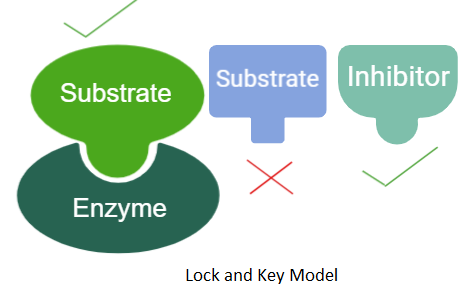
Template/lock and key theory of enzyme action is supported by the fact that
A. Enzymes speed up the reaction
B. Enzymes occur in living beings and speed up certain reactions
C. Enzymes determine the direction of the reaction
D. Compounds similar to substrate inhibit enzyme activity
Answer
552.6k+ views
Hint: Enzymes are biopolymers that are involved in speeding up the reaction rates in various biological reactions. Enzymes are very specific to the substrate they bind. Substrate molecules are those that need to be converted into products. Molecules analogous to the substrate can also bind to an enzyme.
Complete answer:
The template of lock and key theory of enzyme action was given by Emil Fischer in 1894. The model emphasizes the working of enzymes and their specificity towards a particular substrate. Enzymes are biopolymers that are made up of various amino acids. The amino acids fold into their higher-order structures called tertiary structures. These are 3-D structures that have clefts which further have a complementary conformation of the substrate preferred by that specific enzyme. Thus only a specific substrate having a complementary amino acid sequence to that of the active site of the enzyme can bind to that enzyme. This is the basic principle behind the template model of enzyme action.

The active site of an enzyme also presents amino acids that are essential for the enzymatic activity. On the binding of the substrate to the active site of the enzyme, the amino acids at the active site cause chemical reactions. These chemical reactions cause changes in the substrate to form the product. The product formed has a different conformation than the substrate and thus cannot bind to the enzyme. Thus, the product detaches from the enzyme-substrate complex. The inhibitor molecules of the enzyme are analogous molecules that resemble closely to substrate conformation. This makes them compatible to bind to the active cleft of enzymes. The inhibitor molecules mimic the substrate but do not form any product. This makes the enzyme inactive. This is a strong support point for the lock and key model of enzyme action.
Thus, the right answer is option D.
Note: Enzymes are sensitive to temperature and pH changes. Enzymes usually deactivate a higher temperature. This is evident in a sick person suffering from a high fever. The person feels dizzy and lethargic due to reducing metabolism. The reduced metabolism is a result of enzyme denaturation.
Complete answer:
The template of lock and key theory of enzyme action was given by Emil Fischer in 1894. The model emphasizes the working of enzymes and their specificity towards a particular substrate. Enzymes are biopolymers that are made up of various amino acids. The amino acids fold into their higher-order structures called tertiary structures. These are 3-D structures that have clefts which further have a complementary conformation of the substrate preferred by that specific enzyme. Thus only a specific substrate having a complementary amino acid sequence to that of the active site of the enzyme can bind to that enzyme. This is the basic principle behind the template model of enzyme action.

The active site of an enzyme also presents amino acids that are essential for the enzymatic activity. On the binding of the substrate to the active site of the enzyme, the amino acids at the active site cause chemical reactions. These chemical reactions cause changes in the substrate to form the product. The product formed has a different conformation than the substrate and thus cannot bind to the enzyme. Thus, the product detaches from the enzyme-substrate complex. The inhibitor molecules of the enzyme are analogous molecules that resemble closely to substrate conformation. This makes them compatible to bind to the active cleft of enzymes. The inhibitor molecules mimic the substrate but do not form any product. This makes the enzyme inactive. This is a strong support point for the lock and key model of enzyme action.
Thus, the right answer is option D.
Note: Enzymes are sensitive to temperature and pH changes. Enzymes usually deactivate a higher temperature. This is evident in a sick person suffering from a high fever. The person feels dizzy and lethargic due to reducing metabolism. The reduced metabolism is a result of enzyme denaturation.
Recently Updated Pages
Master Class 12 Business Studies: Engaging Questions & Answers for Success

Master Class 12 Economics: Engaging Questions & Answers for Success

Master Class 12 English: Engaging Questions & Answers for Success

Master Class 12 Maths: Engaging Questions & Answers for Success

Master Class 12 Social Science: Engaging Questions & Answers for Success

Master Class 12 Chemistry: Engaging Questions & Answers for Success

Trending doubts
What is meant by exothermic and endothermic reactions class 11 chemistry CBSE

Which animal has three hearts class 11 biology CBSE

10 examples of friction in our daily life

One Metric ton is equal to kg A 10000 B 1000 C 100 class 11 physics CBSE

1 Quintal is equal to a 110 kg b 10 kg c 100kg d 1000 class 11 physics CBSE

Difference Between Prokaryotic Cells and Eukaryotic Cells




